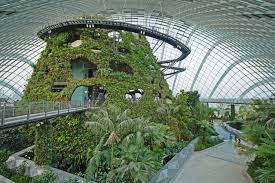Gardens of the World – Seeing is Believing
By Shlomo Maital
Yesterday, Sunday, my wife and I visited Singapore’s remarkable Gardens of the World – domed gardens, showing the amazing flora and fauna of various regions of the world, including a man-made mountain with a walkway (that spiral trail you see is where you walk, viewing an incredible man-made waterfall).
Singapore is only a small archipelago with some 5 million people. Yet it has higher GDP per capita, by some measures, than the U.S. It exports twice as much as its GDP. How? By value-added manufacturing – import components, assemble them, export them.
Singapore, the country, has exceptionally deep pockets, that enable it to afford such incredible structures as Garden of the World. Its Central Provident Fund is the repository for compulsory savings – about a sixth of every pay packet by the employee, and an equal payment by the employer. Singaporeans can draw on this not for consumption but for things like housing. So by law, Singapore’s personal saving rate is a third of national income.
Singapore has a remarkable mindset. As a small country, in a neighborhood that is not always totally friendly to Singapore, it must be alacritous and resilient, to ‘remain relevant’, as a close friend from the Singaporean Foreign Ministry told me. To remain relevant as a small country, you have to be the best at everything you do. Singapore Airlines must have the most video movies of any airline and the best business class. Singapore itself must have attractions for tourists that surpass anything you can see elsewhere. Singapore has to be #1. No excuses. And that no excuse mindset creates remarkable excellence.
Moreover, Gardens of the World has a strong message. Here is the full beauty of G-d’s world, laid out before you, flowers, plants, trees… and we are ruining it through climate change. Let’s take action. When you see the message vividly, first hand, in this manner, it is very powerful. Will our children and grandchildren see the world of beauty as we do? Or will it be gone, as will be the case if we continue to pollute our air and our water and our land.



Leave a comment
Comments feed for this article